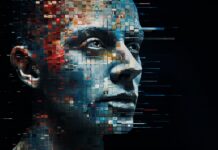Data-driven art is a form of art that uses algorithms to generate new content. These algorithms are fed with data and they create artworks based on the data.
The most common use of these algorithms is to generate new images, music, and text. The output can be in the form of paintings, sculptures, or even music scores. This type of art is mostly used as an exploration tool for artists and scientists who want to experiment with different forms of creativity. It helps people understand data through the eyes of an artist. Moreover, it is an interesting way for people to decipher data and take interest in it altogether.
WWF Endangered species pixelated art
In 2008 the world wildlife foundation joined hands with Mikami Yoshiyuki to depict the decline of the endangered species population. They started with an image of the Giant Panda which had roughly 1600 pixels. The image was distinguishable but the fact that there were only 1600 pixels, 1 for each panda remaining, brought a whole new perspective to it.
Next came the Amur Leopard. With roughly 60 Amur leopards remaining in the world the image was hardly distinguishable.
The idea was brilliant and people soon picked up on it. Later a programmer Joshua Smith developed a Python Script that took the endangered species list from Animal Planet’s website and gave an image of the animals with the same concept. All the animals’ names were replaced by an image of them constructed using the number of pixels of those animals that were still alive.
Ain’t No Grave by Johnny Cash Music Video
A perfect example of crowdsourcing, visualization art, and open-source data. Aaron Koblin along with Chris Milk directed a music video of Johnny Cash’s track Ain’t No Grave. Aaron called upon hundreds of visual artists from across the globe to take part in constructing the video. Each frame has been hand-drawn by a separate artist and it gives the whole video an amazing feel to it.
It not only shows the impact Johnny Cash had on people but also demonstrates the immense power and potential of open-source data and collaborative art.
Water Consumption
We all know that water is the source of life and we also know that we are running out of drinking water at a rapid pace. There is no shortage of information regarding the over-consumption of water but what’s missing is an impactful message that tells the story.
Chesca Kirkland did just that by bringing to light the amount of water being consumed by the production of various foods like Chocolate, cheese, coffee, beer, and many other foods were compared in a glorious manner in what can be called a serious work of ‘data-driven art’. While the first part covers the usage of water in the production of these foods, the second part delves into the water resources available. It includes an infographic about the water footprint per capita per year and the availability of drinking water for the people.The design won First Class Honors in Final Design Futures.
Active Satellites
This infographic was a colorful spectacle created for the Scientific American November 2020 edition. The objective was to show the satellite population without depicting them in an orbit around the earth. The result was a neat, colorful, informative, and easy-to-read data art spectacle sorted by out-of-the-box rows and columns. It showed the number of satellites owned by major countries, the type of satellites, and their orbital height. The artist was also able to depict and compare the sizes of the various satellites and the approximate date of their launch.
The choice of colors, the choice of graphics, and everything else makes this data-driven art a true winner.
Covid Vaccination Tracker
This interactive data-driven art example is of a covid vaccination tracker that is being updated daily. The interactive infographic first has a rotating earth graphic where you can spin the earth and the selected region will display the percentage of people vaccinated with a single shot and a double shot.
Going further the page shows detailed statistics of things like vaccination percentage per region or income group. Covering around 80 countries and 50 US states it is impressive, highly detailed, and very informative.
Data-driven art is an excellent way to convey information to the public with an emotional punch. It takes a fair amount of computer knowledge and skills to come up with a masterpiece like the above examples. Go through them to get inspired and create your own infographics.







